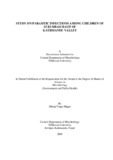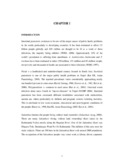Please use this identifier to cite or link to this item:
https://elibrary.tucl.edu.np/handle/123456789/577| Title: | Study on Parasitic Infections Among Children of sukumbasi Basti of kathmandu Valley |
| Authors: | Magar, Dhiraj Thapa |
| Keywords: | public health;laboratory processing;Giardia lamblia;Intestinal parasites;Sukumbasi children |
| Issue Date: | 2008 |
| Publisher: | Central Department of Microbiology |
| Institute Name: | Central Department of Microbiology |
| Level: | Masters |
| Abstract: | Intestinal parasitic infections still constitutes one of the major public health problems in Nepal.Present study was done to find out the prevalence of intestinal parasitosis in children(aged <16years) of Sukumbasi(people living without land ownership) Basti (area), Ward No-34,SinamangalinKathmandu Valley. A total of 279 stool samples were collectedfrom August 2008to December 2008. The samples were collected inclean,dryandscrew capped plastic containerandwere subjected to macroscopic examination for adult parasites and/or segment of parasites.Samples fixed in 10% formal-saline and parasites were examined microscopically afterconcentration byformal ethersedimentation technique.Overall parasite positive ratewas 43.3%with no significant difference in two genders (Boys: 48.3%, Girls: 37.5%)(p=0.07). Thepercentage of monoparasitism (80.1%) were higher than multiparasitism (19.8%).Altogether 11species of parasites were detected of them. Giardia lambliawas most common followed byEntamoeba histolytica, Trichuris trichiura and others. Younger children (aged ≤ 10) hadmarginally higher positive rate (45.4%) than older children (40.8%) (p=0.44).Prevalence ofparasitic infection ratewas higher in family size > 5 (50.0%) than≤ 5 (40.0%) (P=0.1).Positiverate was higher inTibeto-Burman(55.0%) and the least in Indo-Aryan(25.4%)(p=0.01).Theparasitic prevalence rate was higher among children not having toilet (62.1%) compared withchildren having toilet (41.2%) in home. Children drinking water fromkuwa(shallow well) hadmarginally lower prevalence rate (38.6%) than who used tap water (45.0%). The higher infectionrate (52.5%) was observed in children belonging to labour family and the least in the businessfamily (28.1%).Children takinganti-parasitic drug in last six months had low positive rate(25.4%) thanothers(48.2%) (p=0.002).Results showed that nearly half of the children in thisarea had intestinal parasitosis and suggests periodic deworming as well as sanitary hygienicpractices.Key words:Giardia lamblia, Intestinal parasites,Sukumbasichildren,Trichuris trichiura. |
| URI: | http://elibrary.tucl.edu.np/handle/123456789/577 |
| Appears in Collections: | Microbiology |
Files in This Item:
| File | Description | Size | Format | |
|---|---|---|---|---|
| COVER.pdf | 28.92 kB | Adobe PDF |  View/Open | |
| CHAPTER.pdf | 206.75 kB | Adobe PDF |  View/Open |
Items in DSpace are protected by copyright, with all rights reserved, unless otherwise indicated.
